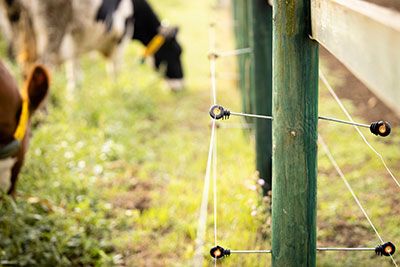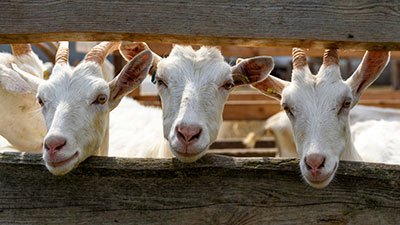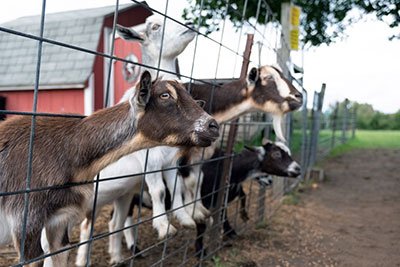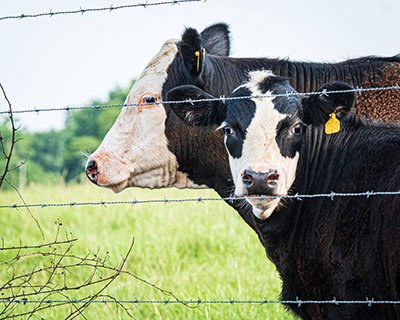If you have farm animals or plan on purchasing livestock, having a secure, safe, and suitable fence is an absolute must.
With so many fence-type options available out there, including electric wire fencing and woven wire fence options with vertical wires, metal farm fencing it can be hard to know where to start.
That’s why we’ve put together this blog post—to give you the information necessary to make informed decisions when selecting the right livestock farm fencing options for your home or business!
Table of Contents
Livestock fencing: choosing the right materials
1. High-tensile tensile fencing
High-tensile fencing is a wire fence type that is known for its strength and durability.
The high-strength steel wire fence can withstand huge animals. High-tensile fence is stronger and more durable than conventional fencing materials.
High-tensile fencing can be strong and durable for livestock. Still, it’s more expensive, requires maintenance, is difficult to install, can cause injuries or pose electrical hazards, and may be less visible. It’s important to weigh these factors before choosing this type of fencing.
The flexible high-tensile cattle ranch fence is sturdy. The pasture wire fencing absorbs heavy animal impacts, reducing agricultural fence damage. Because of its flexibility, it doesn’t need regular repairs.
The high-tensile fence is popular among many farmers and ranchers who desire a strong, long-lasting physical barrier to safeguard their cattle.
2. Electric fence

Electric farm animal fencing deters animals and people by shocking them. Its cables transport electric current from a battery or solar panel. An animal touching the cattle fence wire completes an electrical circuit and receives a harmless shock that deters it from crossing the field fence again.
The advantage of electric field fence is that it provides a psychological barrier for animals rather than a physical one. This means that it is often more effective than traditional fencing in keeping livestock contained, as they learn to avoid the perimeter fence after receiving a shock. Electric fences can also be used in combination with traditional fencing to create a double barrier.
Electric fencing is easy to install and can be moved around if needed. It is also relatively inexpensive compared to other types of fencing. However, it is important to note that electric fencing may not be suitable for all types of livestock, as some may be able to break through the physical barrier.
3. Barbed wire fencing
Traditional barbed wire fences are a type of hinged joint fencing that is composed of sharp metal barbs that are secured to a series of wire strands.
The barbed wire cattle fence is often used as an economical way in agricultural settings to keep livestock contained and is known for its affordability and ease of installation.
The sharp barbs on barbed-hinged joint fences can stop animals from crossing a border. Barbed-hinged joint fencing options should be installed carefully since it might be harmful.
One of the drawbacks of barbed wire fencing is that it can be labor-intensive to install, and it requires regular maintenance to ensure that the barbs are sharp and that the field fence remains intact.
In addition, it may not be the best option for all types of livestock, as some animals may be able to climb over or push through the field fence. Many animals also suffer from festering wounds when they rub against even a single strand of barbed wire.
4. Vinyl fencing
Vinyl fencing is a newer and increasingly popular option for livestock owners. It is a synthetic material made from polyvinyl chloride (PVC) resin, is highly durable, and requires very minimal maintenance.
Vinyl fencing is weatherproof. It doesn’t decay, corrode, or deform like other fence materials. It’s one of the most attractive fence options and lasts for years, making it a good investment for property owners.
Vinyl fence is customizable, with several styles, colors, and textures. It may protect your cattle and beautify your land.
Vinyl fencing has drawbacks such as higher cost, limited flexibility, warping in high heat, difficult repairs, and an artificial appearance, which should be considered before choosing it as a livestock fencing option.
Finally, vinyl fencing is a physical barrier with low maintenance, requiring only occasional cleaning with a hose or pressure washer. Unlike wooden fences, it doesn’t need to be stained or painted, which can save property owners both time and money.
5. Wood livestock fence

Wood pasture fence is a timeless and versatile choice for livestock owners. It is available in a variety of styles and finishes and can be customized to meet the specific needs of each property owner.
It is often less expensive than other types of fencing materials, making it a popular choice among livestock owners. Additionally, a DIY homeowner or a professional can install a wooden post fence because it is relatively simple to do so.
One of the drawbacks of wood farm fences, however, is its upkeep requirements. Wood livestock fence require regular maintenance, such as staining or sealing, to protect against rotting and other damage from moisture and weather. In addition, they may require occasional repairs, such as replacing boards or posts.
The pros and cons of using electric fences for livestock
Electric fences have become increasingly popular among livestock owners for their effectiveness and affordability. However, as with any fencing option, there are pros and cons to consider before making a final decision.
Pros
– Psychological barrier: Electric fences provide a psychological barrier for animals by delivering a small but safe electrical shock upon contact. This makes it an effective way to contain livestock without the expense and maintenance required with traditional fencing. However, the field fence height needs to be carefully planed.
– Flexibility: Electric field fence can be easily repositioned or resized to accommodate changes in the pasture or farm layout.
– Cost-effective: Electric fences are affordable and require less material and maintenance costs compared to traditional fences. However, before you choose the best fencing option, consider the lifecycle cost of the maintenance.
– Lightweight: Electric fences are lightweight and require fewer posts, making them a more portable and temporary solution for fencing needs.
Cons
– Not suitable for all livestock: Electric fences may not be suitable for all types of livestock, such as horses and pigs, as they may be able to break through the barrier. However, it’s wildlife friendly fencing that fights off intruders.
– Potential injury: Improperly installed or poorly maintained electric fences can cause serious injury to both livestock and humans.
– Weather-dependent: Unfavorable weather conditions, such as persistent rain or snow, can affect electric fences and reduce their effectiveness.
– Limited land control: Electric fences are not suitable for properties with varied topography or challenging terrain.
– Power supply: Electric fences require a power source, typically from a battery or solar panel, to be effective.
Installing your livestock fence: Common mistakes to avoid

Proper installation is key to ensuring that your livestock fence is effective and long-lasting. However, there are several common mistakes that people make when installing their fences that can lead to safety risks and costly repairs down the line.
Here are some mistakes to avoid when installing your livestock fence:
Mistake #1: Poor planning
One of the biggest mistakes that people make when installing a livestock fence is poor planning. This includes not considering factors such as property lines, land grade, and potential obstructions. It’s important to have a clear plan and layout before starting the installation process.
Mistake #2: Inaccurate measurements
Another common mistake when installing a livestock fence is inaccurate measurements. This can lead to wasted materials and an uneven fence line. Be sure to double-check your measurements before cutting and installing any fence posts or panels.
Mistake #3: Not properly anchoring posts
Fence posts are critical to the stability and durability of your livestock fence. Be sure to properly anchor each post deep enough into the ground to avoid any leaning or shifting. For larger animals, such as horses or cattle, a deeper post spacing and installment may be necessary.
Corner posts need to be set more deep than the regular posts, as well.
Mistake #4: Incorrect wire and post spacing
If using farm fence with wire mesh fencing and post fencing, it’s important to take into account the type and size of the animals that will be contained. Incorrect livestock wire fencing and post spacing can allow animals to squeeze through or get caught in the fence. Be sure to choose the appropriate cattle wire fence roll and post spacing for your animals and adjust accordingly.
Mistake #5: Incorrect gate placement
Gates are an important aspect of any livestock fence, and their placement can greatly impact accessibility and functionality. Be sure to carefully consider gate placement before installation to ensure ease of movement and safety for both animals and humans.
FAQs
What kind of fencing is best for livestock?
The best type of fencing for livestock varies depending on factors such as the type and size of animals, terrain and weather conditions, and personal preferences, and budget. Some common types include high-tensile, electric fence, vinyl, wooden fence with wooden fence posts, and barbed wire fencing.
What is the longest-lasting livestock fence?

Generally speaking, fences made of high-tensile wire, vinyl, or PVC resin tend to have the longest lifespan when they are installed and maintained correctly. High-tensile wire fences can last up to 40 years with proper maintenance, while quality vinyl or PVC fences can last up to 30 years or more without needing replacement.
What is the cheapest fence to build for livestock?
The cheapest livestock fence options include barbed wire, woven wire fence, electric fence, welded wire fence and split rail fencing. The choice of the cheapest option ultimately depends on the specific needs of the animals and the property’s unique challenges. Proper installation is important for optimal safety and effectiveness.
What is the best fence for cattle and horses together?
The best cattle fence types for containing both cattle and horses together are welded wire fencing with a top rail, high-tensile electric fences with a top rail, vinyl or PVC rail fences, woven wire fences, and wooden posts with three or four-rail fences. These are all durable cattle fence options that require minimal fence maintenance.
Can a cow jump a 5-foot fence?
A cow is generally not able to jump a five-foot fence as long as the cattle fence is well-constructed and in good condition. However, some athletic breeds or particularly motivated animals may be able to clear a fence height.
Can you use a barbed wire fence for sheep?
Using a barbed wire fence for sheep is generally not recommended, as it can easily injure the animals. Barbed wire has sharp metal barbs that can cause cuts or puncture wounds on the fragile skin of sheep.
Final words
To sum it all up, livestock fencing is an essential component of any successful farm or ranch.
The type of fence you use depends on several factors, so it’s important to do some research to ensure that you choose the right one for your particular property and animals.
With careful selection and maintenance, the right kind of livestock and cattle fence can create a safe and secure area for your animals, allowing them to graze and roam without risk of escaping.
